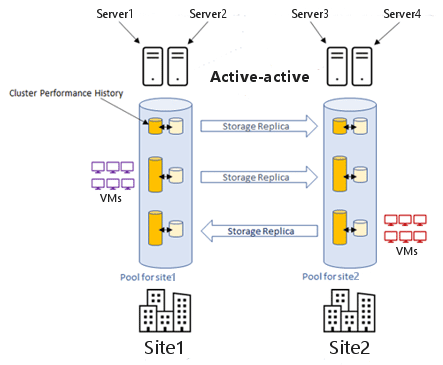| Customer |
Benenden School (https://www.benenden.school/) Benenden School is an independent boarding school for approximately 550 girls aged eleven to eighteen in Kent, England that focuses on academic achievement personal development, and a comprehensive understanding of the world. |
| Product and Services |
|
| Industry | Education |
| Organization Size | 1 to 100 employees |
| Country | United Kingdom |
| Download |
Customer Story (Microsoft) |
- Replacing an aging SAN
- Find a solution with a cost-efficient, flexible, highly scalable architecture
- Balance workloads and disaster recovery across two sites
- Improve performance and resiliency
- Microsoft Integrated System for Azure Stack HCI
- Stretched cluster deployment with an active-active design
- Hybrid NVMe flash and HDD storage
- Azure services, including Azure Arc
- Microsoft Windows Admin Center
- DataON MUST and MUST Pro
- Consolidated infrastructure with highly scalable solution, reducing initial and future scale-out cost
- Improved load balancing, resiliency, and disaster recovery across two sites for 24/7 uptime
- Increased performance by millions of IOPS, improving QoS for students and teachers
- Simplified cluster hardware updating, without downtime or compatibility issues
- Received superior 24/7 support with DataON for hassle-free installation and peace of mind
- Simplified HCI cluster management and future hybrid cloud deployments with Windows Admin Center
Benenden School pilots new Microsoft Azure Stack HCI and boosts resiliency with stretched clusters
Organization
Benenden School is a leading independent boarding school for girls in Kent, England that focuses on providing a complete education, including academic achievement, personal development, and a comprehensive understanding of the world. Founded in 1923, the school has over 550 students from around the world, plus over 300 faculty and staff members at its 250-acre campus.
Challenge
Ready to refresh its aging SAN, Benenden School sought a stable, highly resilient, cost-efficient solution that could ensure uninterrupted 24/7 service on and off campus for its digital curriculum. The school deployed a stretched cluster to extend its infrastructure across two data centers on campus for higher availability and load balancing. Its new solution had to be reliable, stable, and secure, support stretched clusters and load balancing, and boost performance. Benenden School wanted an agile, flexible solution and was not opposed to new technology, but only traditional SANs provided stretched cluster support, which limited its options. It also planned to implement a hybrid cloud strategy and needed a robust solution, but it had to be easy to manage.
The Solution
Benenden School was in the process of evaluating another SAN solution. The school planned to buy iSCSI SAN storage first, as it was its biggest concern, then add servers when more budget was available. However, the COVID-19 pandemic put the project on hold.
Benenden School, a Microsoft shop, had initially considered a Microsoft HCI solution. At that time, Microsoft did not support hyper-converged stretched clusters, and workarounds like Hyper-V replica and automated scripts were regressive to Benenden School’s existing infrastructure stability and resiliency.
During the early months of the COVID-19 pandemic, Benenden School learned about the new Azure Stack HCI as-a-service solution, which would soon support stretched with hyper-converged infrastructures. For Andrew France, Systems Administrator, Benenden School, the stretched cluster feature would be a game changer. It would allow him to stretch his cluster one hundred meters apart via fiber networking between the two data centers. It also had the ability to stretch clusters across cities if need be.
Microsoft referred him to DataON, a Microsoft Gold Partner that specializes in providing Microsoft-validated Azure Stack HCI solutions with Intel technology. Andrew saw DataON’s close partnership with Microsoft and Intel as a key strength. The DataON team quickly identified Benenden School’s application demands, workflows, and infrastructure requirements and offered a solution. As an Intel Select Solution provider, DataON’s Intel-based solutions are validated, using tightly specified hardware and software components and pre-defined settings. In addition, DataON tunes its solutions for best performance and provides benchmarks to customers. All of this was extremely important for Andrew.
Andrew was sold when he learned DataON offered integrated systems for Azure Stack HCI, which included a complete Azure Stack HCI solution with pre-installed Azure Stack HCI software on server nodes powered by Intel technologies, HCI cluster monitoring and management from Windows Admin Center, Microsoft Azure Services, deployment & support services from DataON & Microsoft, and DataON MUST Pro, a tool that allows him to seamlessly update hardware across his cluster in just a few clicks.
“DataON knew exactly what we needed,” Andrew said, “because they have done this a million times before. Having an excellent reputation with Microsoft and Intel and providing benchmarks, we were confident DataON would build the right solution for our team.”
Andrew selected a four-node DataON AZS-212 integrated system for Azure Stack HCI with hybrid storage, configured with Intel® PV610 NVMe flash cache, 420TB of Western Digital Ultrastar HDD raw storage, and Mellanox ConnectX 25GbE networking. The four-node stretched cluster configured with nested mirror-accelerated parity was split into two node pairs, each put in one of the two separate data centers on campus.

Figure 1 : Two -node stretched cluster
The Results
With Azure Stack HCI, Benenden School consolidated its infrastructure and significantly increased performance. “We were able to combine storage and compute into a much smaller payload for us and still keep all of the benefits we currently had with a stretch cluster,” Andrew said. “The build from DataON was amazing. The performance figures went from a few thousand IOPS to millions and cost much less. SANs were really good five years ago but it’s a completely different world now.”
Azure Stack HCI made setting up the stretch cluster a breeze for Andrew. Using an intuitive, straight-forward wizard within Windows Admin Center, Andrew was able to quickly create his stretched cluster sites, automatically set up storage replication, build a data volume, replicate a volume between sites, and choose replication direction and replication mode. The wizard even simplified configuring the volume size, type of resiliency, and media—and it all was done in minutes. Although Andrew had a few minor networking issues, he was able to solve them quickly.
“Configuring a cluster used to take a while to setup,” Andrew remarked. “you would need to roll up your sleeves, and put a lot of work into it, but using Windows Admin Center, the wizard does ninety percent of the work for you.” Windows Admin Center has considerably simplified infrastructure management for Andrew.
Andrew configured an active-active stretched cluster with the integrated system. In this configuration, each pair of nodes at the two data center sites run the same services simultaneously, achieving load balancing across Andrew’s cluster. This configuration ensures that none of the sites are overloaded. Simultaneously, Storage Replica replicates volumes across the two sites for disaster recovery, keeping all servers in sync. If one of Andrew’s sites fails, the automatic failover feature repurposes the replicated drives as data drives at the other site, utilizing them for Windows and VMs, and automatically starts them, keeping production up and running.
When Andrew is ready, he can use Storage Replica to restore quorum. Because Azure Stack HCI keeps a log file of the cluster, he only needs to synchronize the data that was lost or corrupted on his site that failed. This ensures a much faster recovery.
Because his four-node stretched cluster behaves like a two-node cluster with the same resiliency limitations, Andrew chose nested mirror-accelerated parity, a feature unique to Azure Stack HCI. Nested mirror-accelerated parity provides local resiliency for most data using single bitwise parity arithmetic within each server, except recent writes which are mirrored on the node and then mirrored on the second node, essentially creating a four-way mirror. This achieves higher capacity efficiency and enables Andrew’s stretched cluster to withstand multiple hardware failures at the same time without loss of storage availability.
“I was really impressed with the resiliency of the new Azure Stack HCI solution” he said. “We like to break the infrastructure down and build it back up while testing the new environment, which helps us understand how it works.” After causing the two nodes at the first site to fail, the automatic failover kept production running at the second site. Andrew shut down the third node, but it was only after pulling two drives from the fourth node was he able to get the cluster to fail. Because of nested mirror-accelerated parity, Andrew was able to keep his stretched cluster running after losing three nodes and a drive from the fourth node, something he couldn’t do with simple two-way mirroring.
Andrew saw nested mirror-accelerated parity and automatic failover as huge Azure Stack HCI benefits in maintaining 24/7 uptime in his stretched cluster, even if an administrator wasn’t present. He said, “If there is an issue with a cluster, I don’t have to wake up in the middle of the night. I can address it in the morning.”
Because Andrew chose an integrated system for Azure Stack HCI from DataON, he has the help of the DataON support team 24/7. If ever he has a problem, DataON can provide the support he needs and even offer onsite services. The integrated system also includes DataON MUST and MUST Pro for Microsoft Windows Admin Center. DataON MUST provides alert services, historic data reporting, enhanced disk mapping, and a call home service for Azure Stack HCI. MUST Pro adds a complete cluster aware update service.
When Andrew needs to update his hardware, MUST Pro automatically compares Benenden School’s server nodes against the latest quarterly validated server component image baseline from Microsoft. It ensures Benenden School’s servers have the same OS version, drivers, firmware, BIOS, and BMC, and checks the drivers and firmware for network cards, host bus adapters, and SSD and HDD drives. This saves Andrew a significant amount of time because he can update his entire cluster hardware with a few clicks of a button, keep it live, and not worry about compatibility issues that occur with updates that haven’t been validated for his hardware.
With the hybrid cloud ‘built-in,’ Benenden School plans to use Azure Stack HCI’s integrated Azure services, including Azure Arc, and expand its Hyper-V infrastructure into the cloud. Azure Stack HCI works well for organizations because it allows them to keep sensitive data safe and secure on-premises, while still offering the flexibility of the cloud.
Andrew likes how Azure Arc provides visibility, operations, and compliance across a wide range of his resources and locations by extending the Azure control plane. With Azure Arc, Andrew can easily add Azure data services to his on-premises infrastructure. “We couldn’t have done that with our previous technology,” Andrew said. “The DataON solution completely changed what we thought we could do with our data center. We’re still exploring how it changes us and what we can do in the future.”
Tips
After Andrew’s experience with integrated systems for Azure Stack HCI from DataON, he had a few tips to offer. “First, think twice about choosing a SAN. Azure Stack HCI delivers better performance, scalability, and resiliency for substantially less than a SAN. From a usability perspective, Azure Stack HCI and Windows Admin Center streamlined management for us, and creating a stretch cluster was effortless. Second, I recommend choosing an experienced solution provider who works closely with Intel and Microsoft like DataON. Knowing the hardware and software are rigorously tested, you can get the security and stability you need. It gave us confidence when updating our infrastructure. DataON’s commitment to its solutions and service are exceptional.”





